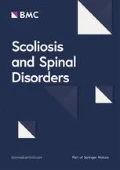Objectives
Interest of a 3D reconstruction software to improve analysis of the three dimensional (3D) deformation of spine and results in the conservative treatment of idiopathic scoliosis.
Material and methods
Prospective comparative study in Centre des Massues (Lyon). Study of a group of 10 adolescents aged 10 to 15 for whom a 3D spine analysis was made before and after brace treatment, using Optispine software. The parameters of interest were correction of the Cobb angle, sagittal curves, and plane of maximal deformation (percentage of vertebrae in the plane, rotation, flexion, abduction).
Results
No significative difference was found between the two groups for the correction of frontal, sagittal plane, or for the plane of maximum deformation. Excluding the lumbar scoliosis (with a short brace correction), the results showed a significative difference in the correction of the thoracic kyphosis.
Discussion
The correction of the sagittal plane is an important parameter for the long term outcoming in children with idiopathic scoliosis. Therefore, it would be interesting to use this simple and fast 3D analysis to improve the quality of orthopaedic treatment.
Conclusion
this preliminary study should be continued in a larger population to confirm these results and their implication in clinical practice.
Author information
Authors and Affiliations
Rights and permissions
Open Access This article is published under license to BioMed Central Ltd. This is an Open Access article is distributed under the terms of the Creative Commons Attribution 2.0 International License (https://creativecommons.org/licenses/by/2.0), which permits unrestricted use, distribution, and reproduction in any medium, provided the original work is properly cited.
About this article
Cite this article
Bernard, JC. Interest of the three dimensional analysis in brace treatment of idiopathic scoliosis. Prospective study. Scoliosis 5 (Suppl 1), O72 (2010). https://doi.org/10.1186/1748-7161-5-S1-O72
Published:
DOI: https://doi.org/10.1186/1748-7161-5-S1-O72

